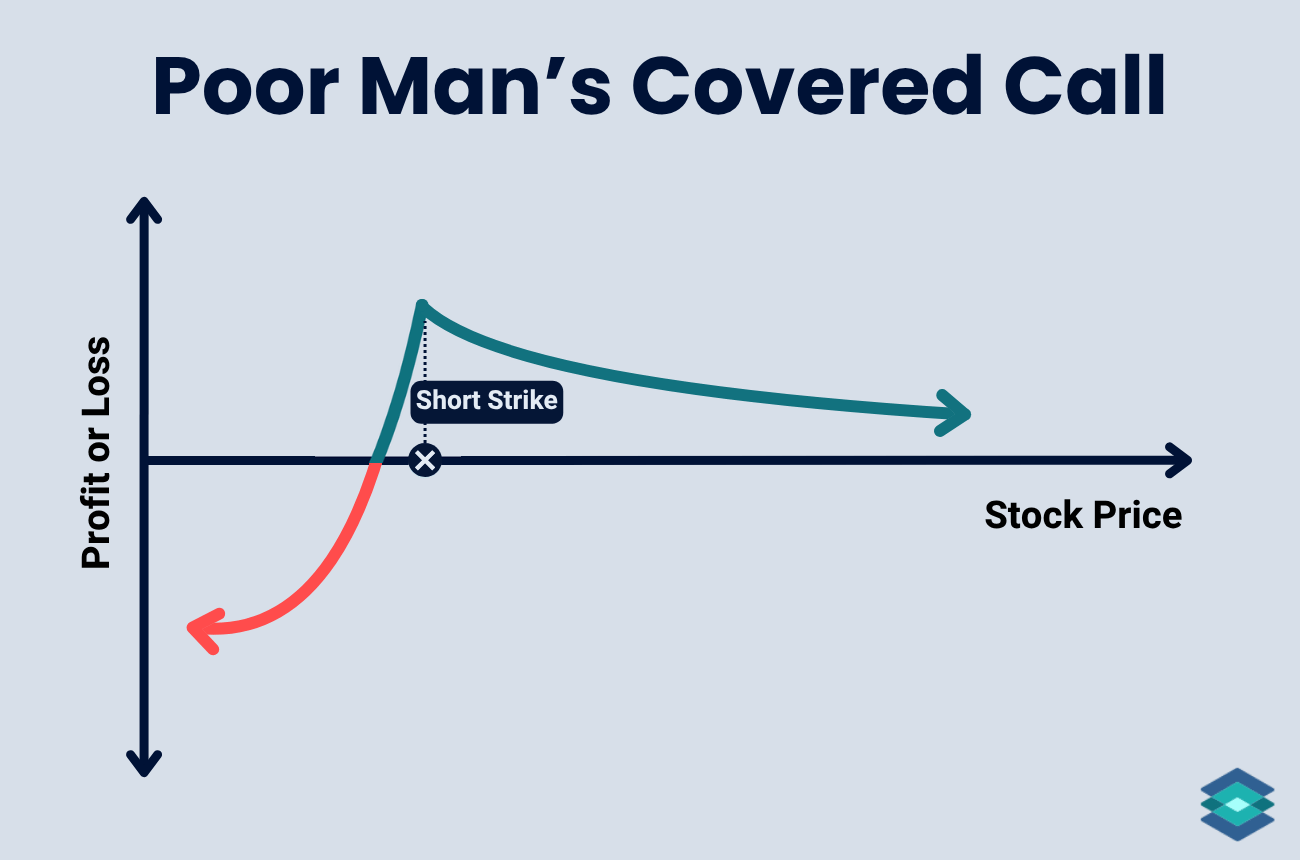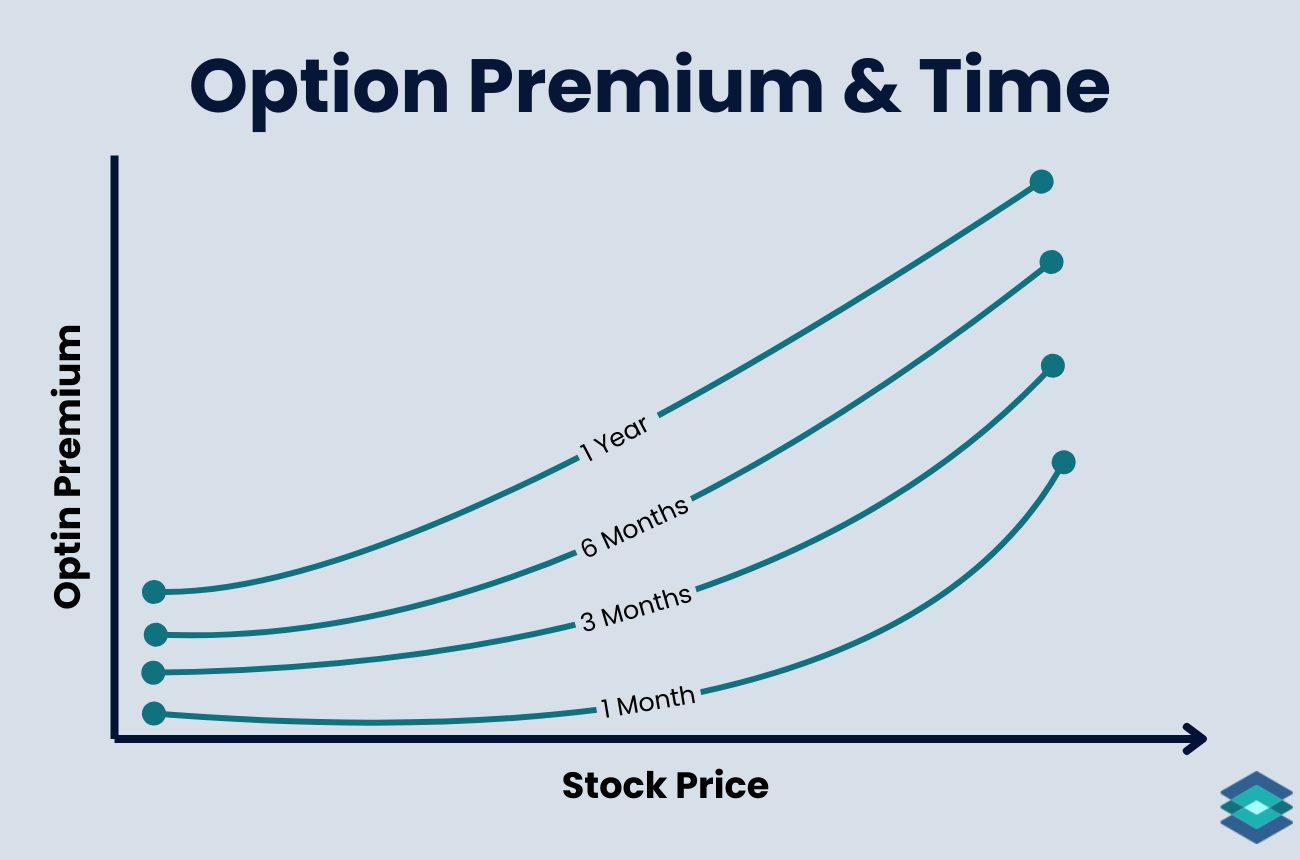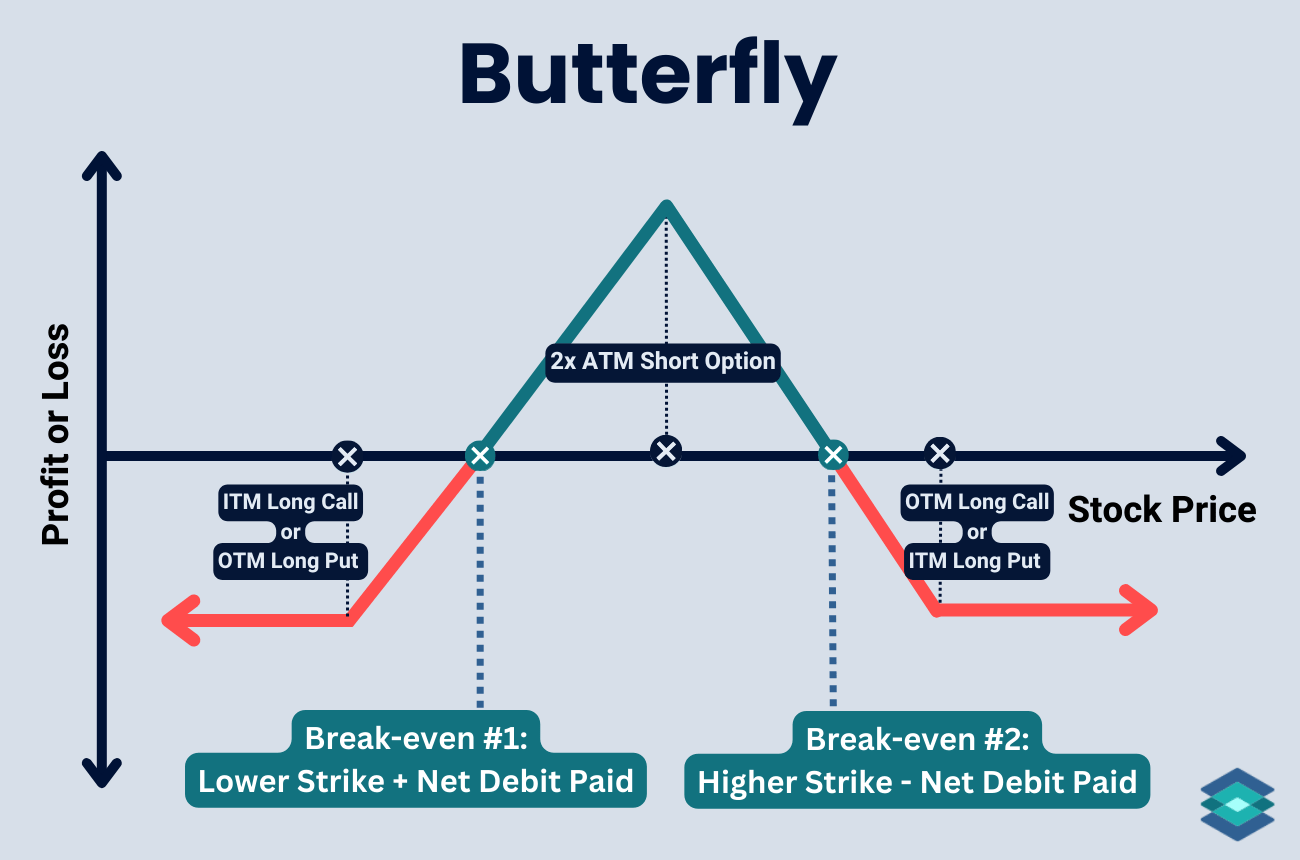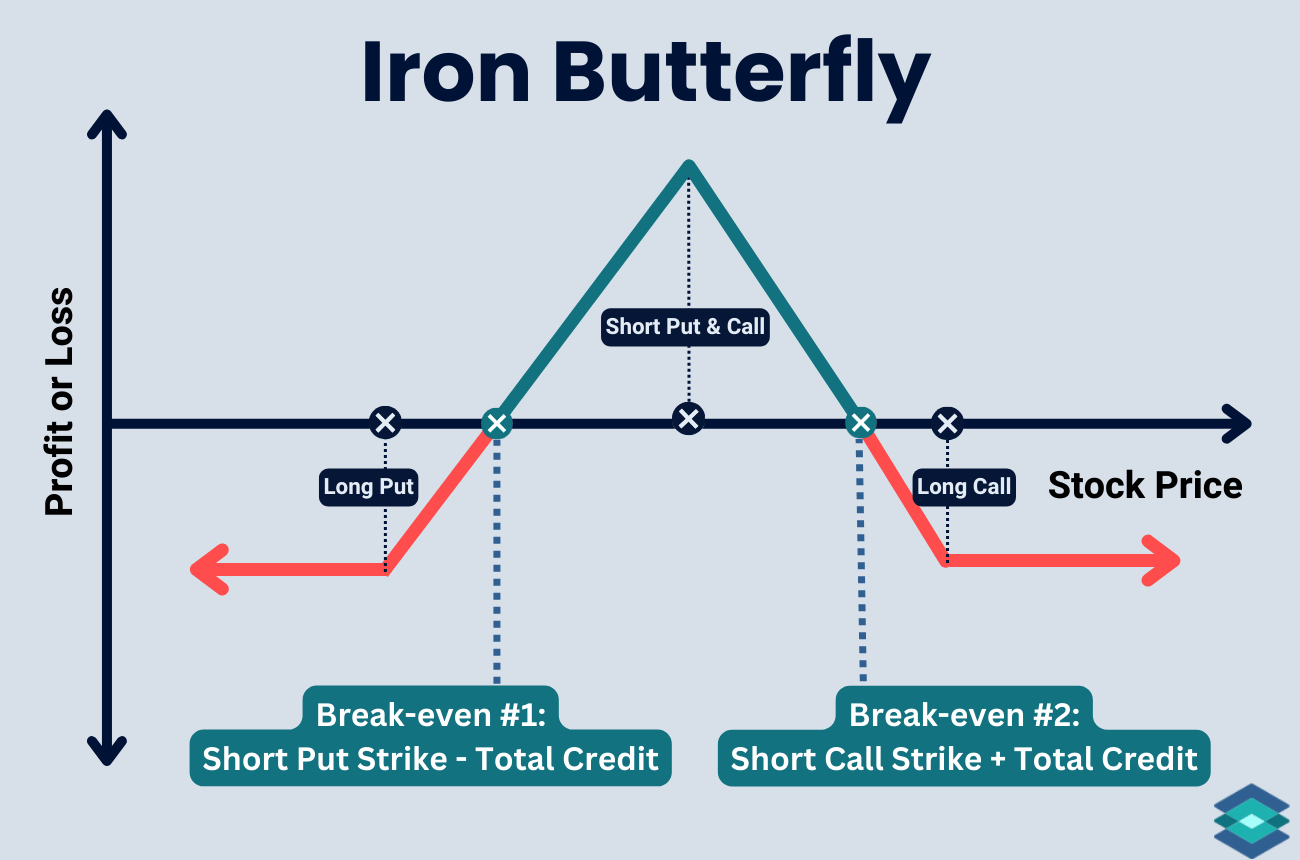Long Iron Condor Options Strategy: Beginner's Guide
A long iron condor is a long volatility options strategy that involves buying an out of the money call spread and an out of the money put spread on the same stock with the same expiration. The trade is designed to reach max profit when the underlying asset breaches the short strike prices.

A long iron condor is a defined-risk, net debit options strategy that involves buying a closer to the money put and call while selling a further out of the money put and call on the same stock with the same expiration. To be a true iron condor, the width of the call spread must equal the width of the put spread.
Highlights
- Risk: Limited to the net debit paid — max loss hits if the stock stays between the long strikes and time decay eats your premium.
- Reward: Capped at the width of the spreads minus the debit paid — max profit happens when the stock moves beyond short options on expiration.
- Outlook: Directional volatility play — you’re betting on a breakout but not sure which way.
- Edge: Works best when implied volatility is low at entry and you expect it to rise — gives you cheap long options that expand if the stock runs.
- Time Decay: Theta chips away at your premium daily.
🤔If you’re new to options trading, it helps a lot to understand how the bull call spread and bear put spread work first before moving on to the long iron condor.
.png)
Long Iron Condor Trade Components
A long iron condor trade has four legs, all of which are out of the money:
- Buy a call option at a lower strike
- Sell a call option at a higher strike
- Buy a put option at a higher strike
- Sell a put option at a lower strike
To be a true iron condor, both options must have the same expiration cycle, and the width of the call spread and put spread must be equal distance.
The long call and put give you upside and downside exposure, while the short call and put help offset the cost, but they also cap how much you can make if the stock moves too far beyond your outer strikes.
If you don’t want directional risk, your best bet is to enter in one trade, as seen below on the TradingBlock dashboard:

Long Iron Condor Trade Cost
Since the long iron condor is a net debit trade, the margin for this trade is simply the debit paid. For example, if you buy an iron condor for 2.10, your net trade cost is $210. This is also the most you can lose on the trade.
When to Buy an Iron Condor
- Directional Bias for a Big Move: You expect the stock to break out sharply in either direction. A long iron condor profits when the underlying moves beyond the outer strikes.
- Low Implied Volatility: You buy when IV is low, but you expect it to rise, which can increase the value of the long options.
- Defined Risk, Limited Cost: You want a defined-risk trade with a net debit to profit from strong movement and rising volatility.
Long Iron Condor: Payoff Profile
Before moving to a real-world trade example, let’s examine the max profit, breakeven, and loss scenarios for a long iron condor.
Maximum Profit Zone
The maximum potential profit on a long iron condor is the difference between the width of the spreads and the option premium paid. Profit occurs when the stock moves beyond the outer (short) strikes.
For example, suppose ABC is trading at $100:
- Buy the 90/95 put spread
- Buy the 95 put for 2.50
- Sell the 90 put for 1.25
- Net debit for put spread: 1.25 ($125)
- Buy the 105/110 call spread
- Buy the 105 call for 2.50
- Sell the 110 call for 1.25
- Net debit for call spread: 1.25 ($125)
- Total debit paid: 2.50 ($250)
In this case:
- The max profit is the width of either spread (5 points) minus the debit paid (2.50). So, max profit = 2.50 ($250).
- You earn this if ABC closes below the lower put strike (short 90) or above the higher call strike (long 110) at expiration.
We can see these two max profit zones below:

Breakeven Zone
The breakeven prices on a long iron condor are found by adding (call) and subtracting (put) the total debit paid from the long options:
- Upper breakeven = long call strike + net debit paid
- Lower breakeven = long put strike - net debit paid
Using our ABC trade:
- Upper breakeven = 105 + 2.50 = 107.50
- Lower breakeven = 95 - 2.50 = 92.50
ABC must finish outside this range (below 92.50 or above 107.50) at expiration for the trade to be profitable, as seen below:

Max Loss Zone
The maximum loss on a long iron condor happens when the stock stays within the long strikes at expiration, leaving all options to expire worthless. Since the trade is opened for a net debit, your risk is capped at the premium paid.
- Max loss = net debit paid
In our ABC trade:
- Spread width = 5.00
- Debit paid = 2.50
- Max loss = 2.50 ($250)
This $250 is your total cost and your maximum risk on the trade. This loss occurs if ABC finishes between the long strikes, 95 and 105, as seen below:

Long Iron Condor: IBIT Trade Example
Bitcoin has been trading in a tight range lately, but with key events and potential catalysts ahead, we expect a breakout in either direction. Implied volatility on IBIT (iShares Bitcoin Trust) options is currently relatively low, which makes it a great setup for a long iron condor.
I like IBIT for a few reasons:
- High trading volume
- Numerous expiration cycles and strike prices
- Bitcoin’s tendency for sudden, significant moves
Selecting Our Options
To give this position room to develop, I’m targeting an expiration just over a month out. I’m also betting on a breakout of more than 5%. I have a slightly bearish bent here, so I’m going to buy my put spread slightly closer to the money than the call spread.
Let’s head to the options chain on the TradingBlock dashboard to choose an expiration cycle and pick strike prices that work for us:

We’re putting on a 4-point wide long iron condor on IBIT, betting on a breakout but keeping the cost down by selling further OTM wings. We’re buying the 64 call and 59 put, then selling the 68 call and 54 put.
Always send your trade at the midpoint and use limit orders on options. If you don’t get filled immediately (and want to), walk your order up in penny or nickel increments until you do. And if you can’t get a decent fill, skip the trade.
We’ll assume we got filled at the midpoint on this one, which means we paid a debit of 1.86:

IBIT Trade Details
And here are the details of the trade we just put on:
Here’s the setup we just locked in:
- Current IBIT Price: $60.95
- Expiration: 32 days
- Buy 59 Put @ $1.77 mid
- Sell 55 Put @ $0.79 mid
- Buy 64 Call @ $1.63 mid
- Sell 68 Call @ $0.75 mid
- Net Debit Paid: $1.86 ($186 total)
- Lower Breakeven: 59 – 1.86 = $57.14
- Upper Breakeven: 64 + 1.86 = $65.86
- Max Profit: Spread width (4.00) – debit (1.86) = $2.14 ($214 total)
- Max Loss: $1.86 ($186 total)
- Profit Zones: Below $55 or above $68 at expiration for max profit
- Risk/Reward: Risking $186 to make $214
Long IBIT Iron Condor: Winning Outcome
Thirty-two days have passed, and expiration is here. IBIT broke out as anticipated and closed at $70, well above our short and long call strikes. This means our call spread finished fully in the money, delivering the maximum possible payout.
- IBIT Price: $60.95 → $70.00 ⬆️
- Expiration: 32 days → 0
- Buy 59 Put @ $1.77 → $0.00
- Sell 55 Put @ $0.79 → $0.00
- Buy 64 Call @ $1.63 → $6.00
- Sell 68 Call @ $0.75 → –$2.00
- Call Spread Value: $4.00 – $1.86 debit = $2.14 gain
- Final Value: Call spread hit max, puts expired worthless
- Net Gain: $2.14 ($214 total)
- Percent of Max Profit Realized: 100%
Let’s now jump to the chart and see how this trade played out in real time.
IBIT Winning Trade: Under the Hood

- Stock broke out past the long call → call spread hit max value
- Puts expired worthless → no value there
- Short call deep ITM → assignment risk spiked near expiration
- Max profit reached → full spread payout minus debit paid
This long IBIT iron condor paid off because IBIT pushed well above the short call, locking in the full call spread value while the puts expired worthless.
Note that because the short call was deep in the money as expiration approached, assignment risk was high. Always watch for early assignment on American-style options when your short strikes are tested.
Long IBIT Iron Condor: Losing Outcome
In this less-than-ideal outcome, IBIT stagnated and closed between our long strikes, our worst-case scenario. Here’s where we ended:
- IBIT Price: $60.95 → $62.00 ⬆️
- Expiration: 32 days → 0
- 59 Put @ $1.77 → $0.00
- 55 Put @ $0.79 → $0.00
- 64 Call @ $1.63 → $0.00
- 68 Call @ $0.75 → $0.00
- Final Value: All four legs expired worthless
- Net Loss: –$1.86 (–$186 total)
- Percent of Max Loss Realized: 100%
Let's take a closer look!
IBIT Losing Trade: Under the Hood
.png)
This trade ultimately resulted in a maximum loss, but consider what could have happened if we had acted sooner. Around 14 days to expiration, about halfway through the trade, we could have closed the call side of the iron condor for 3.80, locking in over 90 percent of the maximum profit.
At that point, the put spread was worthless, so we would have just closed the call side. And if IBIT had crashed afterward, that free put spread would still have been there working for us.
Choosing Deltas on Long Iron Condors
In options trading, delta is the option Greek that tells us how much an option's value may change given a $1 move up or down in the underlying asset. Delta also tells us:
- The number of shares an option ‘trades like’
- The probability an option has of expiring in the money
We will focus on the latter bullet as we explore choosing deltas for our long and short options in the long iron condor.
Choosing Long Deltas
For a long iron condor to be profitable, the stock price must breach one of the long strike prices. As we just learned, delta tells us the probability that an option will expire in the money.
I typically look for deltas between 0.20 and 0.30 on my long options. Adding them together gives you a rough sense of the combined probability of expiring in the money, so in this case, the longs have about a 40–60% chance of expiring in the money.
However, remember that you paid a premium for this trade, so the underlying must breach your long call strike plus the net debit paid, or drop below your long put strike minus the net debit, to turn a profit.
Choosing Short Deltas
The deltas of your short options can vary widely depending on how wide your spread is. For example, if you’re selling a very wide spread, your short strikes might have deltas around 0.05 to 0.10, sitting further out of the money. If you’re selling a narrower spread, your short strikes could be closer to the money, with deltas in the 0.15 to 0.25 range.
When placing the iron condor, your overall delta will likely be close to zero. This is because your long options have positive delta and your short options have negative delta, which mostly offset each other at entry. However, you will have delta exposure if/when the stock prices moves.
Long Iron Condors and Implied Volatility
Long iron condors benefit when implied volatility is low at entry and then rises. A lower IV means you pay a lower premium upfront for long options.
Things to know:
- Low IV = cheaper debit: Entering when IV is low means you pay less for the position.
- IV changes have mixed impact: Rising IV can boost the value of the longs, but it also lifts the shorts — the net benefit can be small depending on how far out of the money your shorts are.
- Closer to expiration = less vega: As expiration nears, the trade’s sensitivity to IV drops — at that point, the trade responds primarily to price movement.
Long Iron Condors and Time Decay (Theta)
Time decay works against a long iron condor. Since you’re a net buyer, you pay a debit upfront, and every day that passes eats away at the premium you paid.
For this trade to profit, the underlying must move far enough to push through your long strikes beyond the premium paid before expiration. If the stock remains in the middle and time runs out, the position loses value as your long options’ decay hurts more than the short options help.

3 Risks of Long Iron Condors
The long iron condor is a four-legged trade, so if you’re not willing to actively monitor and adjust your position, this strategy probably isn’t for you. Here are a few risks to keep in mind:
1. Assignment Risk
This trade includes short options. If one of your short strikes goes in the money, especially near expiration, there’s a chance of early assignment (for American-style options). Early assignment can lead to unintended stock positions and may impact your intended risk/reward. Be extra cautious if there’s little extrinsic value in your short options or an upcoming dividend for short calls.
If both legs of your call or put spread are safely in the money (our ideal outcome) on expiration, they will be exercised/assigned, which will flatten the positions. This is fine, but just make sure the broker fees to do this aren’t too much greater than the commission you would pay to sell the spread. This makes sense for illiquid stocks, where you can’t sell the spread for close to its maximum value before expiration.
2. High Fees
When you trade a four-legged strategy, such as a long iron condor, commissions and fees can add up. Every leg has a cost, and so does every adjustment. If you need to, for example, roll your call spread up, that means even more trades and more commissions eating into your potential profit.
3. Liquidity Risk
Options on thinly traded stocks or ETFs can have extremely thin markets. Signs of low liquidity include:
- Wide bid/ask spreads
- Low open interest
- Low volume.
If you're trading illiquid strikes, you will likely have issues getting filled at a decent price, particularly when volatility jumps. Read more about option liquidity in our dedicated article.
Long Iron Condors and The Greeks
In options trading, the Greeks are a set of risk metrics that help estimate how an option’s price will respond to changes in key market variables. Here are the five most important Greeks to know:
- Delta – Measures how much the option price moves relative to the underlying stock.
- Gamma – Tracks how Delta changes as the stock moves.
- Theta – Measures time decay, showing how much value the option loses daily.
- Vega – Sensitivity to implied volatility, affecting option price.
- Rho – Measures impact of interest rate changes on the option price.
And here is the relationship between long iron condors and these Greeks:
Iron Condor Calculator
Check out our iron condor calculator below to visualize different trade outcomes!
.png)
⚠️ Long iron condors have defined risk, but still require a solid understanding of multi leg option strategies. This trade may not be appropriate for all investors. Profitability can be affected by commissions, fees, and slippage, none of which are shown in the examples above. Be sure to read The Characteristics and Risks of Standardized Options before trading.
FAQ
A short iron condor is a credit spread that profits if the stock stays in a range, so it is market neutral and short volatility. A long iron condor is a debit spread that profits if the stock makes a big move beyond the wings, so it is long volatility and directional in either direction.
A long iron condor is simply buying a call and put option, and then selling a further out-of-the-money call and put option (with the same width). It can also be thought of as buying two vertical spreads - a call spread and a put spread.
To calculate the breakeven on a long iron condor:
- For the lower side, subtract the net debit from the lower long strike.
- For the upper side, add the net debit to the higher long strike.
To calculate profit on a long iron condor subtract the debit paid from the width of the wider spread and then multiply the result by 100.
The maximum loss on a long iron condor is the total debit (premium) paid.
A short iron condor is selling a call and put option, and then buying a further out-of-the-money call and put option (with the same width). It can also be thought of as selling two vertical spreads - a call spread and a put spread.
The maximum loss on a short iron condor is calculated by subtracting the credit received from the width of the spread, then multiplying the result by 100.











